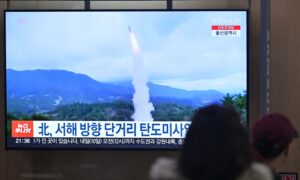North Korea fired two short-range ballistic missiles into the sea on Tuesday, according to the South Korean military, in a tit-for-tat for ongoing U.S.-South Korea military drills on the Korean Peninsula.
The launches occurred within minutes of each other. South Korea’s Joint Chiefs of Staff (JCS) said it detected North Korea firing a missile from the Jangyon area in South Hwanghae province at around 7.41 a.m. (local time) and another one at 7.51 a.m. (local time).
South Korea did not specify how far the missiles traveled.
The JCS said it would maintain “a full readiness posture” with the United States against the possibility of additional launches from North Korea, Yonhap News Agency (YNA) reported.
The latest launches came just two days after North Korea claimed to have test-fired two strategic cruise missiles from a submarine on Sunday—a day before U.S.-South Korea military drills were due to begin.
The cruise missiles were launched from a “8.24 Yongung” submarine and traveled some 1,500 kilometers (932 miles) before hitting a target in the East Sea, North Korea’s state mouthpiece Korean Central News Agency (KCNA) reported.
KCNA said the drill “confirmed the reliability of the weapon system and examined the underwater-to-surface offensive operations of the submarine units” that form part of North Korea’s nuclear deterrent.
‘Incredibly Important’ Drills
South Korea and the United States began their 11-day Freedom Shield exercise on Monday, which includes field exercises on a scale not seen since 2017, when the two allies scaled back public drills to facilitate talks with North Korea.
11th Eng. Battalion doesn’t know the meaning of ‘a bridge too far’ 💪🏽
Wet gap crossing training, Imjin River #WarriorShield
📷 @2INFDIV pic.twitter.com/9n4wc7VROC— U.S. Forces Korea (@USForcesKorea) March 13, 2023
“This routine training exercise is incredibly important for readiness,” Lt. Gen. Andrew Harrison, the deputy commander of the United Nations Command, said in an interview with Yonhap on March 12.
Harrison said that personnel from the “sending states,” who sent armed forces to support South Korea at the start of the Korean War, will exercise crisis management and other contingency procedures during the drills. With no peace treaty, the communist North and democratic South Korea are technically still at war.
“In the early stages of an exercise, we look at the challenge to the armistice that might occur, and we always try and de-escalate back to a sort of pre-crisis position,” he said.
“If crisis turns to conflict, we’re looking at how the sending states could operate together in whatever scenario,” Harrison added.
The United States and South Korea have said that their joint military drills are defensive in nature, but North Korea regards them as “a rehearsal for an invasion” and has vowed “unprecedented” counteractions.
Kim Yo Jong, the sister of the North Korean leader Kim Jong Un, earlier warned that any attempt to intercept North Korea’s missile tests would be considered a “declaration of war” against the reclusive nation.
“The demonstrative military moves and all sorts of rhetoric by the U.S. and South Korea, which go so extremely frantic as not to be overlooked, undoubtedly provide the DPRK with conditions for being forced to do something to cope with them,” she said.
US Capitalizing ‘Every Leg of Nuclear Triad’
General Anthony Cotton, commander of the U.S. Strategic Command, said last week that the United States would capitalize on its nuclear triad to defend South Korea against North Korea’s aggression.
The U.S. nuclear triad refers to three systems of U.S. nuclear weapons, including nuclear-capable heavy bombers, long-range ballistic missiles, and nuclear-armed submarines.
“North Korea continues to be a rogue actor and poses a threat to the United States and our allies,” Cotton told the Senate Committee on Armed Services on March 9.
“To ensure our continued ability to serve as the bedrock of integrated deterrence, we are recapitalizing every leg of the nuclear triad, and the nuclear command, control, and communication systems,” he added.
North Korea conducted a series of missile launches last year, including one involving its largest intercontinental ballistic missile, the Hwasong-17, all of which are banned under U.N. Security Council resolutions on North Korea’s missile program.
The United States has persisted in engaging “direct talks” with North Korea without preconditions in favor of a diplomatic solution, but North Korea has rebuffed these efforts.
Reuters contributed to this report.

